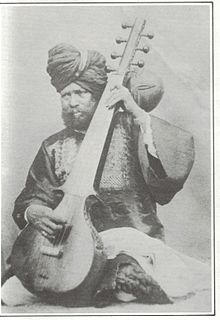
The sursingar (IAST: sursiṅgār), sursringar or surshringar (Sringara: Pleasure in Sanskrit), is a musical instrument originating from the Indian subcontinent having many similarities with the sarod. It is larger than the sarod and produces a deeper sound. It precedes the sarod chronologically.
In Dhrupad style, it was used as a solo instrument in the 19th and 20th centuries. It is regarded as a further development of the Dhrupad-Rabab that has more or less disappeared today.[1] Its neck has a metal fingerboard and the steel and bronze strings are played with a metal pick, while the bridge is made of a flat horn. It has two resonant boxes; the main box is made from a cut gourd, on which a wooden cover is attached.[2]
- ^ "SURSRINGAR BY MONOJ KUMAR SARDAR". www.indian-instruments.com. Retrieved 14 November 2017.
- ^ Ram Avtar Vir. Musical Instruments of India. ISBN 81-87155-65-5